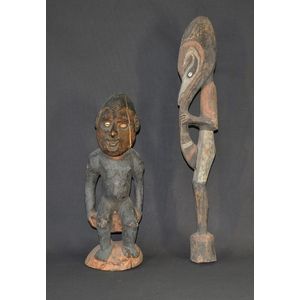Rare Nepalese Bronze Standing Figure of Avalokitesvara
A rare Nepalese bronze standing figure of Avalokitesvara, 10th-11th century, finely cast in tribhanga with a sensuous curved body, the hair in a high chignon behind the three-point Crown, a mandorla behind the head, very well patinated, 26.5 cm high. Reference: see Von Shroeder, Buddhist sculptures in Tibet, India and Nepal, vol. 1, 2001, cat. No. 159 C, D && E, p. 497, also cat. No. 16Oa, p. 498 for very similar examples. Provenance: Carlo Cristi, 6/7/2006, invoice number: 02-06
You must be a subscriber, and be logged in to view price and dealer details.
Subscribe Now to view actual auction price for this item
When you subscribe, you have the option of setting the currency in which to display prices to $Au, $US, $NZ or Stg.
This item has been sold, and the description, image and price are for reference purposes only.
- Bronze - An alloy of copper and tin, traditionally in the proportions of about 9 parts of copper to 1 part of tin.
The discovery of bronze in Western Asia in the 4th century enabled people to create metal objects which were superior to those previoulsy possible because of its strength and hardness, and it has been used throughout the world for weapons, coins, tools, statuary and other decorative items.
It is very fluid in a molten state, and its hardness, strength when set, and non-corrosive properties makes it most suitable for casting sculpture.
This item has been included into following indexes:
Visually similar items

A Nepalese bronze Bodhisattva, vajra and bell in hands, seated on lotus pedestal, 44.5 cm high
Sold by
in
for
You can display prices in $Au, $US, $NZ or Stg.

A Sino-Tibetan bronze figure of green Tara, modelled with an ornate headdress and seated upon a double lotus base, 19 cm high. 19 cm high
Sold by
in
for
You can display prices in $Au, $US, $NZ or Stg.

Two Papua New Guinea carved figures. Sepik bird totem; and seated orator. Height 78 cm. (bird)
Sold by
in
for
You can display prices in $Au, $US, $NZ or Stg.

Oriental deity figure 16.5 cm high
Sold by
in
for
You can display prices in $Au, $US, $NZ or Stg.
